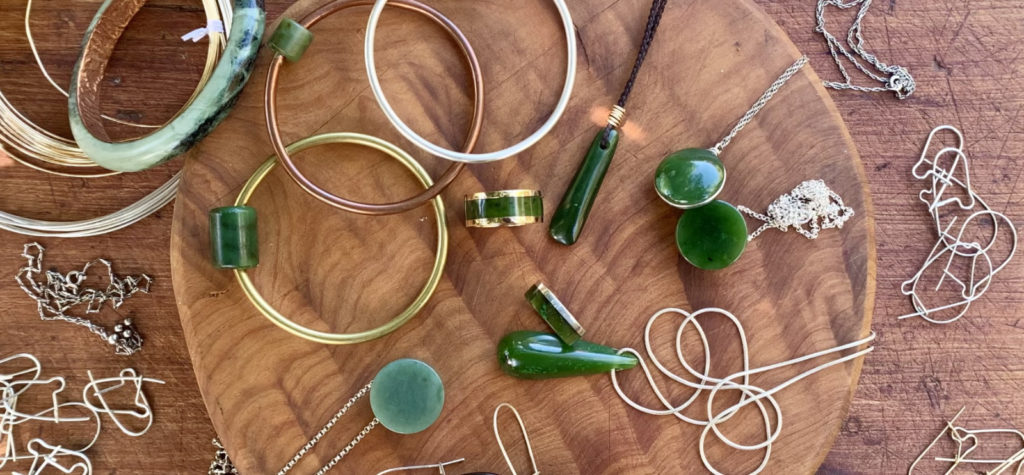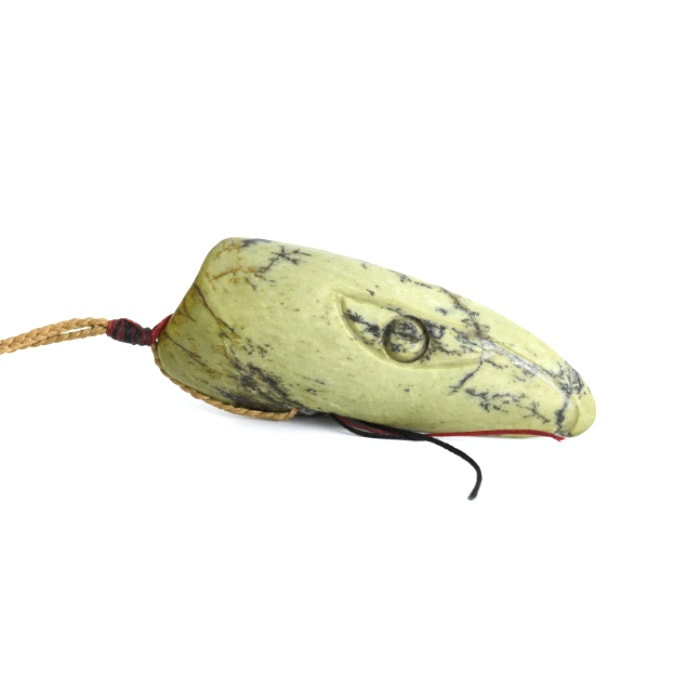Can pounamu be worn with metal?
It’s an interesting question this one, and oddly, one we hear a lot. I say oddly because the only way we can think to answer this question is to ask another – why not?
Why would it not be ok to wear pounamu with metal?
One of the most common answers we hear is, because Tangata Whenua wouldn’t have used it historically. Fair enough, we get that. However neither would Tangata Whenua have used plastic waxed cord traditionally either, but no one seems to be questioning that!
Another common answer we hear is that pounamu should only be strung with leather. This one also gives us a chuckle. Again because, why? Why should pounamu only be strung on leather? Inevitably the answer is because it is natural, or sometimes even because that’s what Tangata Whenua used historically.
The first answer we get. Yes, it is a natural fibre and if that suits you better then great. But wait, aren’t metals natural? So then why can’t we wear pounamu with metal? You see why this question makes us giggle.
The second theory, that leather is what Tangata Whenua used historically, well that’s just incorrect as far as we understand. From all our research we can not find any evidence that Tangata Whenua used leather to string any taonga with.
The only use of leather by Tangata Whenua, that we are aware of, was in the creation of cloaks. Kahu Kuri (dog skin cloaks) were magnificent cloaks made from prized dog pelts. Bird and seal skins were also used to make beautiful, warm and waterproof cloaks.
(Would love to hear any further information on the use of skins by Tangata Whenua if anyone has more to share on that).
So this all leads us to the question, what did Tangata Whenua historically use to string pounamu taonga?
Muka.
Muka is a fibre made from the Harakeke plant. The fibre is made by striping the green outer layer from the Harakeke frond to reveal the beautiful silken threads within. These then go through various actions(such as rolling, soaking, beating and dying) depending on how they are intended to be used.
Muka is more than just a material. Muka symbolises the unseen and connects the physical and spiritual realms – te ira tangata (the realm of people) with te ira atua (the realm of the gods).
Muka has a beautiful feel and look to it. When made properly muka cord lasts for years – see the taonga still in existence around the country for evidence of that. Muka just looks right with the pounamu and sets it off beautifully. Actually, our ultimate goal is to one day string all our taonga on muka. We even have the Harakeke plants growing and are practising our muka making skills. Making muka is quite an art, but the end goal is worth it.
So, if we are going to use exactly what our tupuna used when strining pounamu taonga then we would need to use muka.
Pounamu contains metal.
Another point to consider in this ‘pounamu with metal’ debate is that pounamu is made up of a combination of minerals of which Iron is one of the main players. Iron gives pounamu its distinct green colour. The kiri of pounamu comes about through the oxidisation of the iron content within the pounamu. The oxidisation of the iron also creates the beautiful gold and red hues we often see in the kohatu.
We wouldn’t have pounamu without iron. In addition to that, we wouldn’t have pounamu without magnesium. Another metal. If you want to get all sciencey about it, this is the chemical make up of Nephrite Ca2(Mg, Fe)5Si8O22(OH)2 Bowenite Mg3(OH)O4Si2O5 and Serpentinite Mg6Si4O10(OH)8. And that’s just surface level, the metal contents on each of these pounamu vary depending on where they are found and can include chromium, nickel, cobalt and aluminium amongst others.
So, if the whakapapa of pounamu includes metals as its tupuna, then why would it not be ok to wear pounamu with metal? You can’t have one without the other, so why would you need to separate them? Riddle me that.
The other side of this argument to consider is that if pounamu can not be with metal then 99% of carvers would need to down tools and reconfigure their workshops to use only stone tools. And you then wouldn’t be wearing all the pounamu jewellery that you are or all those intricate designs we see that were never carved by our tupuna. So if you are suggesting pounamu cannot be put together with metal then you also need to consider what tools were used to make the pounamu taonga you are wearing. I can guarantee you that 99% of the time those tools were made of metals.
To recap, the question was, can I wear pounamu with metal? Our answer is, why not?
Saying that pounamu can’t be worn with metal because it’s not what Tangata Whenua used historically, well that’s an interesting argument and a good one. However, Tangata Whenua did not historically use leather to hang taonga from either. Nor did they use polyester cord, for that matter. They used muka. So if we can only use what the tupuna used then we need to shift to using muka binding on all our taonga.
And if you are going to go down this line of argument then where do you end – should pounamu only be carved with stone tools, down at the awa or moana by men in korowai? This is an interesting rabbit hole and we thoroughly encourage it. We love a good rabbit hole. However, we need to stick to answering the original question of this blog so we will leave that rabbit hole for another day.
The other argument, that leather is a natural product and is what should be used with pounamu, well aren’t silver and gold natural products too? We can’t quite get our head around this line of disagreement, to be honest.
Personally, we love pounamu with metal, the silver and gold really set off the colours in the pounamu. In addition to that, metal lasts for many years, it can be fixed if needed and when it finally gets to the point that it can’t be used with your pounamu anymore it can go back to the earth from whence it came, or melted down to make something else – the perfect material if you ask us.
In summary, if you feel comfortable wearing your pounamu with metal then we know of no reason why you shouldn’t. If you don’t feel comfortable wearing pounamu with metal then don’t.
Asking these questions is a necessary thing and we encourage it wholeheartedly. It’s important to break down the many mystical myths that have grown up around the mahi of whakairo Pounamu and Te ao Māori in general. And as we explore the answers we learn and grow in our knowledge and understanding of Te ao Māori – essential for every resident of Aotearoa. So keep asking those questions, even if you feel silly. We are here for it.
Whāia te mātauranga hei oranga mō koutou
Seek after learning for the sake of your wellbeing



I love this korero.
Personally I think what matters is the whakapapa and the journey of each taonga/Pounamu.
I would like to think each taonga have their own mauri and that essence is extended and shared in its journey from papatuanuku to the wearer.
I love the idea of Muka myself and that’s personal preference. And that’s not to say I don’t like metals, my Aunty had a pair of ataahua Pounamu earrings that were set in sterling silver and I’ll never forget them because they were absolutely stunning.
Much respect to our tupuna carvers back in the day and carvers of today.
Ngā mihi for sharing your korero. I could harp on but I need to get to work lol.
Pai tou rā
Mōrena Helen,
āe, absolutely, we agree. The whakapapa and the journey is what really matters because each taonga has its own mauri. And āe, we love the look and feel of muka too. Although the colours of gold, silver, brass against the different pounamu can be absolutely stunning too.
Thanks for taking the time to read and comment. It’s so important to have these discussions and sift out the truth from the chaff. Mahi tahi.
Kia pai tō rā Helen.
I agree fully with your korero. Metals are natural also and the fact that they can make a stunning piece of pounamu look even more beautiful, why not?! Adorn yourself with all the beautiful things in this world whether they are “traditional” or not. They carry the same mauri and make you feel good so why put limitations on things like that?
Wonderfully said Kiri, why put limitations on these things? It’s quite fascinating to wonder where some of these ‘superstitions’ come from. Lets enjoy the beauty. Thanks for taking the time to read and comment.
I didn’t know that.
Glad we can learn together! What had you known previously?
That’s an awesome point
Thank you! And thanks for taking the time to read it
Great to see someone of your calibre shedding some light on this. Our tūpuna were incredible innovators and used the resources they had available with the knowledge they had at the time.
I saw these beautiful tāonga that were made using 3D printing technology, the material was a bio-plastic called PLA (based on corn starch and other natural materials). The meanining behind the taonga carried much significance for the person who was wearing it and drew them closer to their tūpuna because the design had meaning and relevance to them.
Kia Ora! Agreed, our tūpuna were incredible innovators. And saw the value in new technology and ideas. They were quick to take up metal tools and machinery. And knew how to express themselves through images and design. It is wonderful to see how we are still innovating and creating. A culture that doesn’t grow and change is a dead culture. Te ao Māori is very much alive. Thanks for sharing your thoughts and comments.